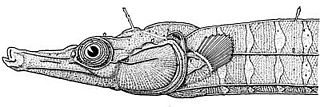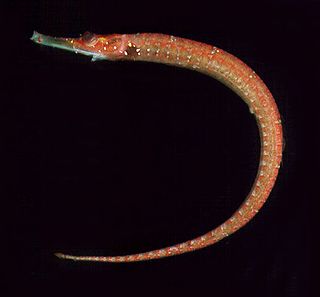
The Syngnathidae is a family of fish which includes seahorses, pipefishes, and seadragons. The name is derived from Ancient Greek: σύν, meaning "together", and γνάθος, meaning "jaw". The fused jaw is one of the traits that the entire family have in common.

Pipefishes or pipe-fishes (Syngnathinae) are a subfamily of small fishes, which, together with the seahorses and seadragons, form the family Syngnathidae.

The greater pipefish is a pipefish of the family Syngnathidae. It is a seawater fish and the type species of the genus Syngnathus.

The northern pipefish is a northwest Atlantic species of fish belonging to the family Syngnathidae.
The Yucatán pipefish is a demersal fish species native to the Gulf of Mexico.

Cosmocampus is a genus of pipefishes.

The snake pipefish is a species of pipefish, from the family Syngnathidae, native to the northeastern Atlantic Ocean where they are generally found amongst algae close in to shore. It is the largest species of pipefish recorded in European waters and has spread into arctic waters in the early 2000s.
Minyichthys is a circumtropical genus of pipefishes consisting of species from the Indo-Pacific and eastern and western Atlantic regions. The genus is characterized as having a maximum standard length of about 60 mm, with two or three anal fin rays. Minyichthys species can be differentiated from members of the closely related genus Micrognathus by their higher frequency of total subdorsal rings.
Hippichthys cyanospilos, commonly known as the blue spotted pipefish or bluespeckled pipefish, is a marine fish belonging to the family Syngnathidae, native from the Indo-Pacific area.

Cosmocampus albirostris is a marine fish of the family Syngnathidae. It is found in the western Atlantic Ocean, along the US coast from North Carolina to Florida, in the Gulf of Mexico, along the Yucatán Peninsula to Cuba, in the Caribbean from Puerto Rico to Grenada, and along Central and South America to southern Brazil. It lives among coral reefs, sea floor rubble, and sparse algae to depths of about 40 metres (130 ft), where it can grow to lengths of 20 centimetres (7.9 in). This species is ovoviviparous, with males carrying eggs in a brood pouch and giving birth to live young The Cosmocampus albirostris is a species of pipefish that has been historically collected in the State of Bahia. These species are in the Brazilian list of marine fishes that are authorized to be exported for ornamental purposes. This information was taken from a case study that monitored the ornamental trade of seahorses and pipefishes in Brazil, where harvesting of pipefish is common, and it was also discovered that Cosmocampus albirostris are predominantly harvested in reef areas.
Cosmocampus balli is a species of fish of the family Syngnathidae. It is endemic to Hawaii, with observations off Oahu and Kauai. It lives in shallow, protected coral reef or rocky habitats, where it can grow to lengths of 7 centimetres (2.8 in). Although little is known about its feeding habits, it is expected to consume small crustaceans, similar to other pipefishes. This species is ovoviviparous, with males carrying eggs and giving birth to live young. Males can brood at 4.5 centimetres (1.8 in).

Cosmocampus banneri is a species of marine fish of the family Syngnathidae. It is found from the Red Sea and Western Indian Ocean to Fiji, the Marshall Islands, and the Ryukyu Islands. It lives in coral reefs at depths of 2-30m, where it can grow to lengths of 5.8 cm. Although little is known about the feeding habits of C. banneri, it is expected to feed on small crustaceans similar to other pipefish. This species is ovoviviparous, with males carrying eggs in a brood pouch until giving birth to live young.
Cosmocampus brachycephalus is a species of marine fish of the family Syngnathidae. It is found in the western Atlantic Ocean, near southern Florida (USA), the Bahamas, and northern South America. It lives in sub-tidal grass flats to depths of 10 metres (33 ft), where it can grow to lengths of 10 centimetres (3.9 in). This species ovoviviparous, with males carrying eggs and giving birth to live young.
Cosmocampus elucens is a species of marine fish of the family Syngnathidae. It is found in the western Atlantic, off the U.S. east coast, Bermuda, the Bahamas, the Gulf of Mexico, throughout the Caribbean Sea, and off the coast of Brazil. It lives in seagrass and algae beds, typically at shallow depths, where it can grow to lengths of 15 centimetres (5.9 in). It is expected to feed on small crustaceans, similar to other pipefishes. This species is ovoviviparous, with males carrying eggs and giving birth to live young.
Cosmocampus heraldi is a species of marine fish of the family Syngnathidae. It is known from only seven specimens, which were found at the Desventuradas and Juan Fernandez Islands in Chile. It inhabits rocky reefs and sandy areas at depths of 6–23 metres (20–75 ft), where it can grow to lengths of 7 centimetres (2.8 in). It is expected to feed on small crustaceans like other pipefish. This species is ovoviviparous, with males carrying eggs until giving birth to live young.
Cosmocampus howensis is a species of marine fish of the family Syngnathidae. It is found in the South Pacific from Jervis Bay to Easter Island. It lives in lagoons and on rocky reefs, where it grows to lengths of 10–12 centimetres (3.9–4.7 in). It is expected to feed on small crustaceans, similar to other pipefishes. This species is ovoviviparous, with males carrying eggs before giving birth to live young.
Cosmocampus investigatoris is a species of marine fish of the family Syngnathidae. It is found in the Indo-West Pacific, from the Persian Gulf to the Gulf of Thailand. It lives over sand, mud, and coral bottoms to depths of 15m, where it can grow to lengths of 9 cm. This species is ovoviviparous, with males carrying eggs in a brood pouch until giving birth to live young.

Cosmocampus maxweberi is a species of marine fish of the family Syngnathidae. It is found in the Red Sea from Sumatra to Tonga and Samoa, and from the Marshall Islands to the Great Barrier Reef. Adults live in reefs and reef-rubble to depths of 36 m, while planktonic juveniles have been found in the top 85m of 1500–2000 m water columns. Adults are expected to feed on small crustaceans, similar to other pipefish, and can grow to lengths of 10 cm. This species is ovoviviparous, with males carrying eggs until giving birth to live young.
Minyichthys inusitatus, also known as the West Atlantic pipefish is a species of marine fish belonging to the family Syngnathidae. They have been be found off the coast of Panama and Northern Argentina, though little is known about their full geographic range or preferred habitat in these areas. Minyichthys inusitatus is thought to live primarily at depths of greater than 30–40 meters. Their diet likely consists of small crustaceans such as copepods, amphipods, and mysid shrimps. Reproduction occurs through ovoviviparity in which the males brood eggs before giving live birth. This small species grows only to lengths of around 2.9 cm on average.
Minyichthys sentus is a species of marine fish belonging to the family Syngnathidae. Little is known about this species preferred habitat and their proposed geographic distribution is based on only three specimens, two found in the Atlantic near Southern Spain and one found in the Mediterranean near Gibraltar. They have been recorded at depths of up to 170 meters.







